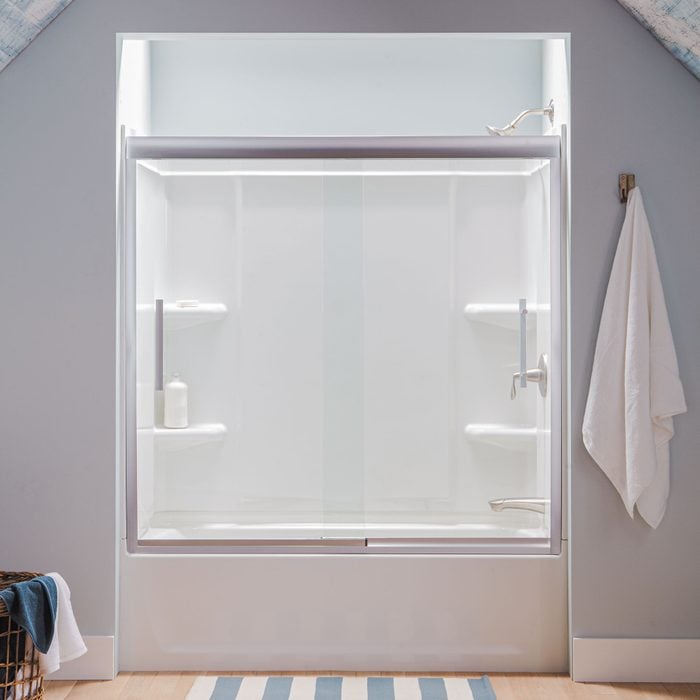What Is a Bathtub Surround?
Updated: Feb. 12, 2024

Looking for a new tub surround? Learn the pros and cons of fiberglass, acrylic, solid-surface and engineered stone options.
A new bathtub surround is a fast and cost-effective way to transform the look of your bathroom. I can attest to their ease of installation and durability, because I’ve installed several in my rental properties.
When choosing the right surround for your home, the options can be overwhelming. To help you decide, we spoke with two Massachusetts-based bathtub surround experts, Thomas Murphy from Bath Busters and Will Martinez from W Remodeling and Handyman Services of Springfield.
They explain the pros and cons of each tub surround type, related costs and whether you can DIY this bathroom remodeling project.
On This Page
What Is a Bathtub Surround?
A bathtub surround is a single piece or three-paneled unit installed on the walls above a tub. Made of non-porous materials, tub surrounds provide a waterproof surface for a shower space. They can be simple, flat panels or elaborate units with textures and shelves.
What Types of Materials Are Bathtub Surrounds Made From?
Primarily fiberglass, acrylic, solid surface and engineered stone materials. “There are composites of acrylic and fiberglass out there as well,” Murphy says.
The choices:
- Fiberglass tub surrounds: Formed with layers of fiberglass reinforced with polyester resins. This is less expensive and can be flimsy and thin.
- Acrylic tub surrounds: Generally thicker and more chip- and scratch-resistant than fiberglass. “Some acrylic units could last a lifetime, if cared for right,” Murphy says.
- Solid-surface tub surrounds: Made of acrylic, polyester resins and crushed mineral dust for a durable and easy-to-clean material.
- Engineered stone tub surround panels: Made from real stone material and resins. “It’s a mixture of stone dust, acrylic and an adhesive to give it a real stone look,” Murphy says. Available in lots of styles, composite surrounds can look like granite, quartz or marble.
How Much Does a Bathtub Surround Cost?
Expect to pay $130 to $2,500, depending on the material and design.
Fiberglass surrounds can cost $130 to $600. While the cheapest options may be tempting, I encourage you to spend at least $300 to $400 for a higher quality fiberglass tub surround. “The cheap fiberglass is really low quality,” says Martinez.
Acrylic surrounds are mid-range, at $600 to $800. The thickness, stiffness and appearance of the product will determine the price. Options with a tile pattern or built-in shelving cost more.
Solid-surface composite surrounds cost $800 to $1,800 or more. “You pay more, but it’s really durable and low maintenance,” Martinez says.
An engineered stone tub surround can cost $1,200 to $2,500 or more.
How Much Does It Cost to Install a Bathtub Surround?
Professional installation runs $800 to $10,000 or more. “Make sure to shop around,” Murphy says, “There can be a big price difference between companies offering the same services and products.”
Installation costs also depend on the material of the new surround, the installation method and the condition of the existing walls.
Fiberglass tub surrounds should cost $800 to $1,000 to install.
For a standard acrylic tub surround installation, Martinez charges between $800 to $2,000. “It could be more if there are tile walls that need to be removed before installation,” he says.
Solid-surface surrounds often have a seamless installation method with clips and screws that requires nuance to do right. Consequently, the cost is higher. Expect to pay $2,000 to $4,000.
Installation of an engineered stone tub surround should cost between $3,000 to $5,000. “Engineered stone panels are more difficult to install,” Murphy says, “It could be a two-day job.”
Can You Install a Bathtub Surround Yourself?
It depends. Solid surface and engineered stone surrounds are best left to the pros.
Experienced DIYers with the correct tools and know-how can install a fiberglass or acrylic bathtub surround and save some money. That’s what I do in my rentals.
Each bathtub surround is different, so carefully follow the manufacturer’s instructions for a successful DIY project.
Martinez offers potential DIYers this warning: “There’s a lot to consider, and you can run into a lot of problems, like plumbing problems, uninsulated walls, rotted floors. It’s always something.”
FAQs
Is it better to tile or use a tub surround?
It depends. There are so many factors that make this a personal decision of what is ‘better.’ Martinez favors tile, but if you’re on a tight budget or hate cleaning grout lines, a tub surround may be your ‘right’ choice.
What’s the best material for a bathtub surround?
Again, it depends. All tub surround materials are acceptable, so which is the ‘best’ will depend on your personal situation. Consider your budget, the level of use, how long you will live in your home and your aesthetic preferences.
Can you put a tub surround over old tile?
Yes. Glue-on fiberglass and acrylic panels can be installed over any existing wall, including tile. “You just have to make sure to use the right adhesive,” Martinez says.
Which is better to put behind a tub surround, drywall or cement board?
Murphy says his company uses moisture-resistant drywall or Zip board behind tub surround installs. “It’s a breathable, engineered wood that’s water-resistant,” he says.
About the Experts
Thomas Murphy is the general manager of Bath Busters in Leominster, Massachusetts, a major bath remodeling company that has completed more than 32,000 bathroom remodels.
Will Martinez owns W Remodeling and Handyman Services of Springfield, Massachusetts. He has more than seven years of home and bathroom remodeling experience.
